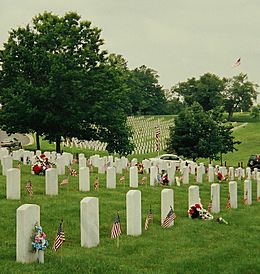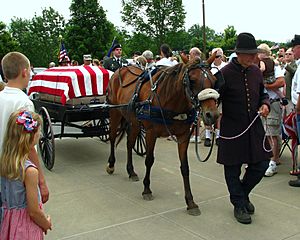Camp Nelson National Cemetery facts for kids

Camp Nelson National Cemetery on Memorial Day, 2003.
|
|
| Lua error in Module:Location_map at line 420: attempt to index field 'wikibase' (a nil value). | |
| Details | |
|---|---|
| Established | 1866 |
| Location |
6890 Danville Road, Nicholasville, Kentucky
|
| Country | United States |
| Type | Veterans |
| Owned by | Department of Veterans Affairs |
| Size | 30.2 acres (12.2 ha) |
| No. of graves | 12,000+ |
|
Camp Nelson National Cemetery
|
|
| Architect | Montgomery C. Meigs |
| Architectural style | Second Empire |
| MPS | Civil War Era National Cemeteries MPS |
| NRHP reference No. | 98001134 |
| Added to NRHP | September 3, 1998 |
The Camp Nelson National Cemetery is a special burial ground in Jessamine County, Kentucky. It is a United States National Cemetery, which means it's a place where military members and veterans are honored. This cemetery was first part of Camp Nelson, a very important place during the U.S. Civil War.
The camp was named after Major General William "Bull" Nelson. He was a leader in the Union Army during the Civil War. The cemetery is now managed by the United States Department of Veterans Affairs. It covers about 30 acres of land.
More than 12,000 people are buried here. Most of them were active duty members of the U.S. Armed Forces. Many were also veterans or their family members. About 2,452 burials are from the Civil War. Among these, 837 are graves of African-American soldiers. Their gravestones have "USCT" on them. This stands for "United States Colored Troops".
Contents
History of Camp Nelson Cemetery
The cemetery started in 1863. It was a place to bury Union soldiers. These soldiers died while serving at Camp Nelson during the Civil War. The first burial ground was near the camp hospital. About 379 people were buried there by 1865.
A second burial area, called "Graveyard No. 2", was then chosen. This area is now the main part of the cemetery. Between 1865 and 1866, 1,183 soldiers and civilians were buried there.
Expanding the Cemetery After the Civil War
After the Civil War, the government wanted to honor fallen soldiers. They started a program to find Union soldiers' bodies. These bodies were often buried in small, scattered graves. The goal was to rebury them in national cemeteries. This showed respect and helped care for the graves.
In 1866, 8 acres of land were set aside for the cemetery. It officially became a National Cemetery. A stone wall was built around it in 1867 and 1868. In 1868, the remains of 2,023 Union soldiers were brought here. They came from battlefields in places like Frankfort and Richmond. They were reburied with honor at Camp Nelson.
Confederate Graves at Camp Nelson
At the same time, the bodies of Confederate soldiers were moved. They were taken from Camp Nelson. They were reburied in a public cemetery in Nicholasville. Some went to private cemeteries.
In the 1990s, something interesting happened. It was found that two Confederate soldiers might have been buried here by mistake. They were thought to be Union soldiers. Since moving the old graves was too hard, their headstones were changed. They now have special Confederate gravestones. These are the only two known Confederate graves at Camp Nelson.
From the Past to Today
Camp Nelson National Cemetery has grown over time. In 1874, more land was added. In 1875, a house was built for the cemetery's superintendent. This brick house was designed by Quartermaster General Montgomery C. Meigs. It was built in a style called Second Empire.
The cemetery accepted burials until 1964. Then, in 1975, 10 more acres were given to the cemetery. This allowed new burials to begin again. More land has been bought since then. This helps the cemetery welcome veterans from World War II and more recent conflicts.
In 1995, the old superintendent's house became the main office and visitor center. Also in 1995, the Daughters of the Union put up a granite monument. It honors Union soldiers from the Civil War. In 1997, a new flagpole was put up. It has an area around it for gatherings.
A special building called a committal shelter was also built. This is a covered area for funeral services. It helps families during bad weather. It also makes it easier for older visitors. Inside, there is space for a casket and chairs for family members. In 1998, Camp Nelson National Cemetery was added to the National Register of Historic Places.
In 2010, the cemetery bought 21 more acres. This land was from the Camp Nelson Civil War Heritage Park. This new land is expected to double the cemetery's capacity. It could hold up to 30,000 graves in total.
Annual Events and Ceremonies
Every year, special ceremonies are held at Camp Nelson National Cemetery. These happen on Memorial Day and Veterans Day. They used to be held in the old, walled section. But since 1997, they are held at the flagpole area near the front gates.
On Memorial Day, there is often a main speaker. A local high school band might play music. A bugler plays Taps, a special military song. There is also a cannon salute. People dressed in Civil War-period uniforms often act as an honor guard. They represent units like the 54th Massachusetts Infantry. This was an all-black regiment famous from the movie Glory.
The ceremony also includes a procession. A horse-drawn wagon carries an empty, flag-draped coffin. This represents all military members who have died. A soldier then leads a riderless horse. This is another way to honor those who have been lost. In 2010, over 1,000 people attended the Memorial Day ceremony.
Who Can Be Buried Here?
Any veteran of the U.S. Armed Forces can be buried at Camp Nelson. They must have left the military under honorable conditions. A veteran's husband or wife and dependent children can also be buried here.
The grave plot, headstone, and care of the grave are all free. The work for the burial is also free. Since the 1990s, special plastic containers called burial vaults are used. These protect the casket and keep the ground from sinking. They are also provided at no extra cost.
At a veteran's funeral service, an American flag is placed over the casket. At the end of the service, it is carefully folded. Then, it is given to the veteran's closest family member. If the family wishes, "Taps" will be played during the service.
Cemetery Staff
One director oversees Camp Nelson National Cemetery. The director and an assistant work in the office. They help families and funeral homes schedule services. They also organize the annual ceremonies. They keep records and answer questions from the public.
There are also six full-time cemetery caretakers. In the summer, more temporary workers are hired. These caretakers prepare graves using tools or a backhoe. They handle the casket and lower it into the grave. They also fill in the grave.
Caretakers also set up headstones. They keep the grounds looking nice. This includes cutting grass, pruning trees, and clearing roads. They also get the funeral shelter ready for services. They help visitors find graves and answer questions.
How to Visit Camp Nelson
Camp Nelson National Cemetery is best reached by car. It is about 15 miles south of Lexington, Kentucky. The closest airport is Blue Grass Airport in Lexington.
From the airport, you can take Man o' War Boulevard east. Then turn south onto Nicholasville Road (U.S. Route 27). Drive about 15 miles, and the cemetery will be on your left. It is just before the bridge over the Kentucky River.
The cemetery is open to visitors every day from dawn until dusk. The office and visitor center are open Monday through Friday. They are open from 8:00 AM to 4:00 PM, except on federal holidays.
Notable Burials
- William Fowler (1815–1862): He was the first non-white legislator in Wisconsin. He was a sergeant in the 21st Wisconsin Infantry Regiment. He died from injuries during the Battle of Perryville.
- William M. Harris (1850–1878): He received the Medal of Honor. He was a Private in the 7th U.S. Cavalry. He was honored for his actions during the Battle of the Little Bighorn in Montana.



